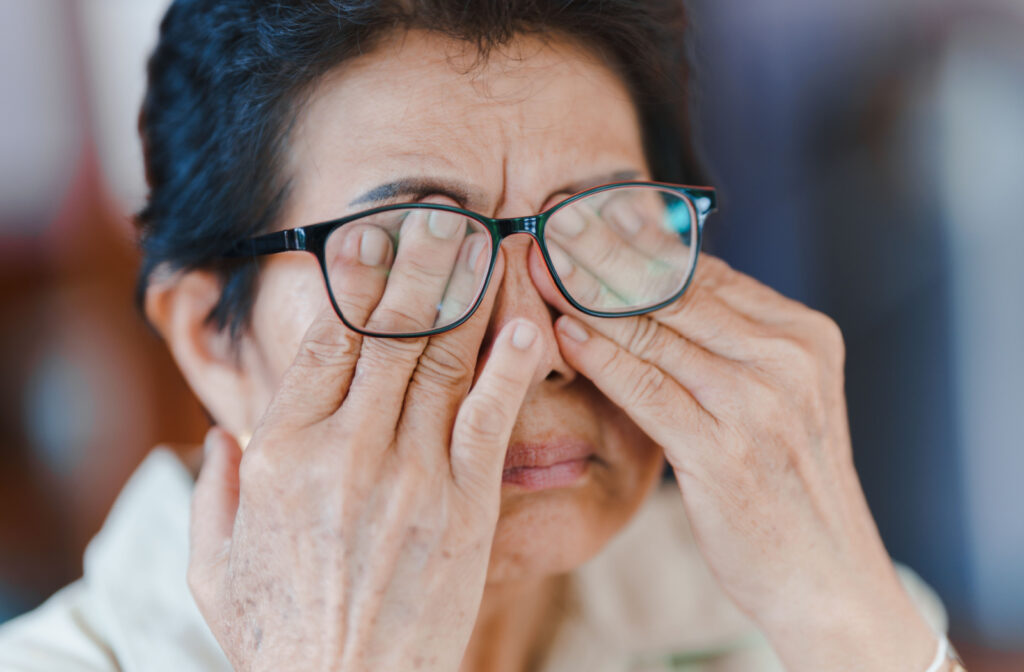The human eye is a complex and delicate organ, and maintaining its health is crucial for clear vision and overall well-being. The cornea is a transparent, multiple tissue layer found at the front of the eye. It must remain clear at all times for clear vision. One condition that can significantly affect eye health and visual acuity is corneal edema causing corneal cloudiness.
Corneal edema, also known as corneal swelling, is a condition in which the cornea accumulates excess fluid. This accumulation causes the cornea to become swollen and thickened and lose its transparency.
If untreated, this eye issue can significantly affect your vision. An ophthalmologist, specially trained in cornea transplantation and disease, can recommend treatment options to alleviate the corneal swelling and help clear up your vision.
What Causes Corneal Edema?
The cornea is the clear, dome-shaped window at the front of the eye. It plays a vital role in focusing vision and protecting the eye from infection and injury. The cornea has 5-6 layers: the epithelium, Bowman’s layer, the stroma, Descemet’s membrane, the endothelium, and sometimes an additional layer called Dua’s layer.
Corneal edema occurs when fluid builds up in the cornea. It is usually caused by a problem that affects the inner layer of your cornea, known as the endothelium. In most eyes, this membrane pumps fluid out of the cornea to keep it thin and transparent, at a very specific level of hydration. When damaged endothelial cells can’t pump fluid out properly, it builds up in the cornea and leads to swelling and thickening, which causes the cornea to lose its transparency, and a patient to experience severe cloudiness in vision.
Some medical conditions can contribute to corneal swelling, including:
- Fuchs’ Endothelial Dystrophy: A genetic disorder that causes the deterioration of the corneal endothelial cells, which are responsible for maintaining the cornea’s clarity.
- Endotheliitis: Inflammation of the corneal endothelial cells, often resulting from different infections or autoimmune disorders.
- Glaucoma: A condition often marked by increased pressure within the eye, which can damage the cornea and lead to edema.
- Posterior Polymorphous Corneal Dystrophy: An inherited condition that affects the corneal endothelium, causing it to thicken and lose its ability to function effectively.
- Chandler’s Syndrome: A rare disorder in which abnormal growth of the corneal endothelial cells leads to corneal swelling and vision problems.
- Trauma: direct damage to the cornea from an injury can lead to loss of endothelial cells and corneal clouding.
Corneal edema can also develop following eye surgeries and during the use of some medications.
Symptoms of Corneal Swelling
The buildup of fluid in the cornea can cause vision to become cloudy and distorted. This is because it prevents light from entering the eye properly, often resulting in:
- Blurred vision
- Haloes around lights
- Eye discomfort and pain
- A feeling that something is stuck in your eye
- Fluctuating vision throughout the day
It’s essential to seek medical attention if you experience any of these symptoms, as they could indicate an underlying condition that needs treatment.
How to Treat Corneal Swelling
Treatments may not be necessary in cases of mild corneal edema as the swelling might resolve independently. However, to temporarily relieve swelling in the eye, your eye doctor may recommend using concentrated saline drops or ointment. These solutions, containing a balanced salt-and-water mixture, can help alleviate discomfort and reduce corneal swelling.
One option for treating severe corneal swelling or edema is corneal grafting or transplantation. This surgical procedure involves replacing damaged layers of your cornea with healthy corneal tissue provided by a donor.
Your ophthalmologist can recommend which type of corneal grafting to consider based on your needs.
Penetrating Keratoplasty (PK)
Penetrating Keratoplasty is a full-thickness corneal transplant, replacing the patient’s entire cornea with a donor cornea. The donor cornea is carefully sized, cut, fitted, and sutured in place.
Lamellar Keratoplasty
During Lamellar Keratoplasty, only selective layers of the cornea are replaced, preserving the healthy layers.
Deep Anterior Lamellar Keratoplasty (DALK)
Deep Anterior Lamellar Keratoplasty (DALK) removes all layers of the cornea except for the 2 bottom layers, Descemet’s membrane and the endothelium.
Anterior Lamellar Keratoplasty (ALK)
Similar to the DALK procedure, Anterior Lamellar Keratoplasty (ALK) surgery only removes the uppermost layers of the cornea, including the epithelium, Bowman’s membrane, and upper parts of the stroma.
Endothelial Keratoplasty
Endothelial Keratoplasty specifically targets and replaces the bottom layer of the cornea, known as the endothelium.
Descemet’s Membrane Endothelial Keratoplasty (DMEK)
Descemet’s Membrane Endothelial Keratoplasty (DMEK) replaces the bottom most layers of the cornea, Descemet’s membrane and endothelium.
Unlike anterior procedures that use sutures, DMEK employs gas to keep the ultra-thin endothelial donor graft in place during the early postoperative period, providing faster visual recovery and a lower risk of graft rejection.
Descemet’s Stripping (Automated) Endothelial Keratoplasty (DSAEK)
Descemet’s Membrane (Automated) Endothelial Keratoplasty (DSAEK) replaces the 3 most posterior layers of the cornea, a thin bottom part of posterior stroma, and also Descement’s membrane and endothelium.
Similar to DMEK, DSAEK employs air to keep the ultra-thin endothelial donor graft in place during the early postoperative period, providing faster visual recovery and a lower risk of graft rejection.
Corneal Care at Vector Eye Centre
If you are experiencing complications from a corneal injury or other corneal diseases, there is hope for improving your sight and preventing further progression. Vector Eye Centre offers a comprehensive list of corneal treatments and a corneal specialist tailored to your specific needs to restore your vision and overall eye health.
As each patient’s situation is unique, it is crucial to schedule an assessment with our experienced ophthalmologist, with extra fellowship training in cornea, to determine if corneal surgery is appropriate for your specific concerns. Schedule a consultation today and let our experienced team evaluate your eye health and recommend a course of action to address your corneal concerns.



